This is one of the bloodiest battles of antiquity and one of the greatest victories of Alexander the great. Moreover, modern commanders could envy the ingenuity of both warring sides. During the siege of Tire, engineering troops, amphibious ships and even combat divers were used!
After the victory over the forces of the Persian king Darius III at Issos, Alexander the Great led his troops along the shores of the Mediterranean Sea towards Egypt. There, other cities surrendered to him without a fight:Tripoli, Beirut and Sidon. They agreed to recognize the sovereignty of the Macedonian ruler and to pay the levies imposed by him, in return for which the conqueror respected the local laws and the existing administration.
In January 332 BCE Alexander's army stood under the walls of Tire, one of the most powerful fortresses of antiquity. In this case, the victorious leader was disappointed. The townspeople refused to submit to his authority. They have stated that they will remain neutral as long as the Persian-Macedonian war continues.
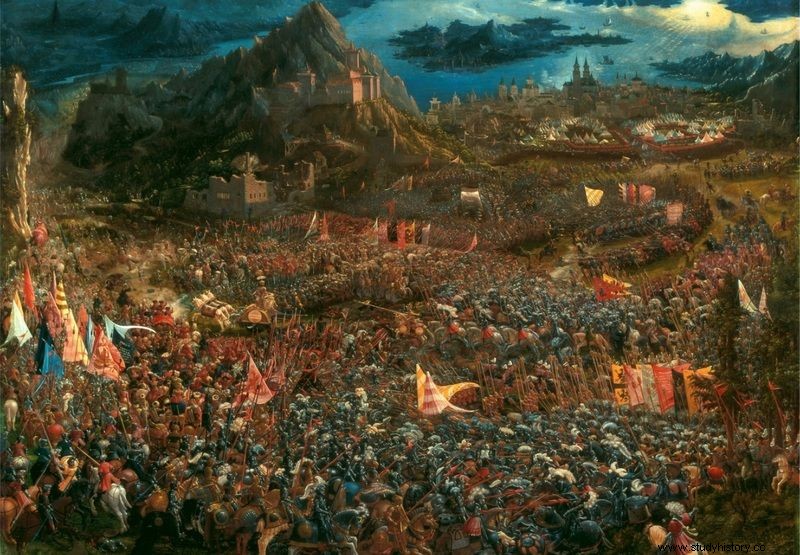
The defeat of the army of Darius III at Issus opened the way for Alexander to Egypt. The illustration shows a battle in the painting by Albrecht Altdorfer (source:public domain).
The furious Alexander sent his parliamentarians to the city, proposing a peaceful settlement of the conflict. The confident Tyrians, believing in the power of their walls, lost the envoys of the Macedonian conqueror in front of his soldiers . The invaders' camp was in turmoil. Until now, they had been reluctant to storm the fortifications, now they wanted revenge. This is what their leader was counting on.
The most powerful stronghold of antiquity
The city was then divided into two parts. The first of them, located on the mainland, was called the "old Tire". The second was on a rocky islet about three kilometers in diameter, 800 meters from the coast. It was there that the main point of resistance and the base of the Phoenician fleet were located. The garrison numbered about 35 thousand. residents and soldiers. There were 80 ships in the port.
The walls, which were up to 45 m high, rose above the sea. Approaches to them were defended by numerous catapults, crossbows, and even machines in the shape of rotating wheels that destroyed incoming missiles. It was impossible to conquer such a fortress using the methods that were conventional at the time:using ladders and rams. It took some method and a fleet that Alexander did not have at the moment.
According to reports, the Macedonian commander personally inspected the underwater fortifications of the fortress, using a diving bell . Perhaps it was then that the idea of building a dike leading to the walls came to him. The besiegers moved quickly to action.
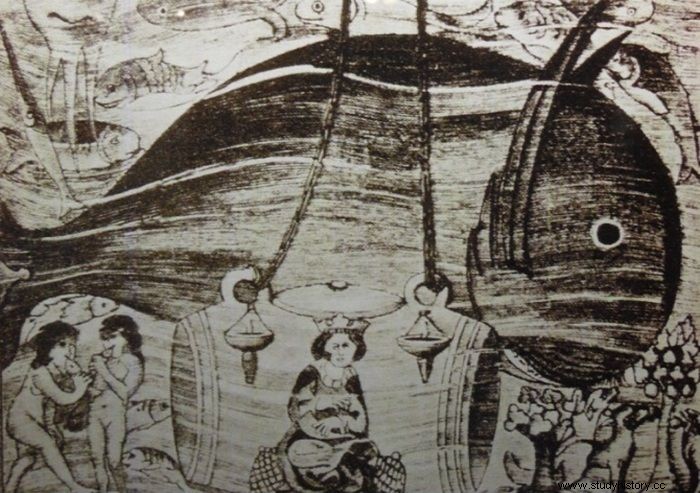
Alexander the Great in the diving bell. Graphics presented at the National Maritime Museum in Gdańsk (photo:Dariusz Kaliński).
The engineering troops used stones and rubble obtained from the seized and demolished old Tire. Wooden logs were dragged from the hinterland to the supports. In addition, in order to accelerate the progress of work, thousands of local residents were forced to work on the construction site as forced laborers.
Grobla
In its final shape, the dyke was to be about 60 meters wide. Alexander wanted to attack on the broadest possible front. To protect his soldiers, working under the hail of missiles fired from the fortress, he ordered two large siege towers to be built.
From their peaks, archers and slingers could strike the fortress's crew. In addition, a huge ram was built, equipped with a long trunk ended with a stone head, to be used to break the walls.
At the same time, the actions of the Tyrians were not only limited to shooting at Macedonians. The defenders made numerous forays beyond their fortifications, harassing the enemy. They sent, among others eight ships which began shelling workers and soldiers from both sides working on the dike. Many people died then.
Despite these bloody losses, construction progressed and the causeway neared the walls of Tire. In response to the attack, Macedonians began to protect themselves from projectiles with leather and cloth curtains.
Tyr strikes back
The crew of Tire then decided to destroy the very structure of the dyke. A horse ship was used as a brander. It was loaded with sawdust, tar, sulfur and various flammable materials. Two Phoenician triers towed him towards the Macedonian building.
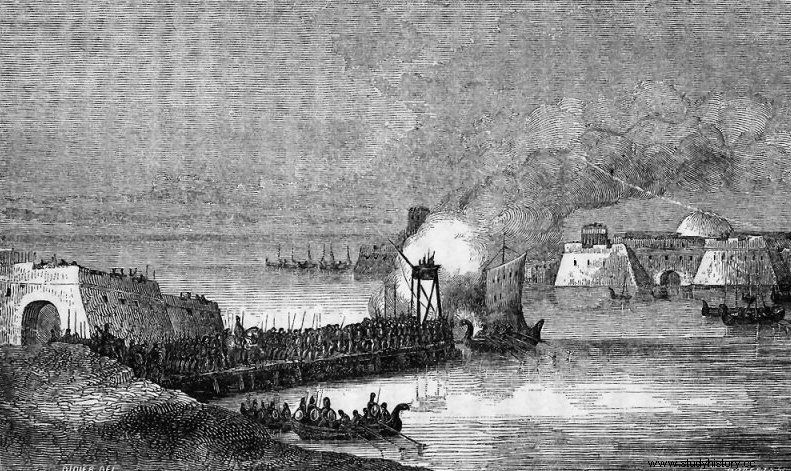
The defenders of Tire decided to destroy the causeway with a brander filled with sawdust, tar, sulfur and various flammable materials (source:public domain).
The ship sped up, and just before the collision, both Phoenician ships diverged from side to side. The brander's sparse crew set him on fire and jumped overboard. The speeding floating bomb exploded into the causeway, igniting the wooden elements of the structure . Both siege towers burned down as well.
In the meantime, the triers previously used as tugs have returned to their place. Archers struck Macedonians from their decks trying to put out fires. In turn, a flotilla of small Tyrian units imperceptibly blew up two landing units nearby . One of them cut down the porters wearing building materials, the other burned the rest of the siege devices .
After this event, Alexander concluded that he would not be able to break the resistance of the defenders without his own fleet. He left the camp and went to Phoenician cities which had previously obeyed him and had ships at their disposal, incl. to Sidon. Cyprus also sent its sea contingent. In a short time, the Macedonian man amassed around 200 units.
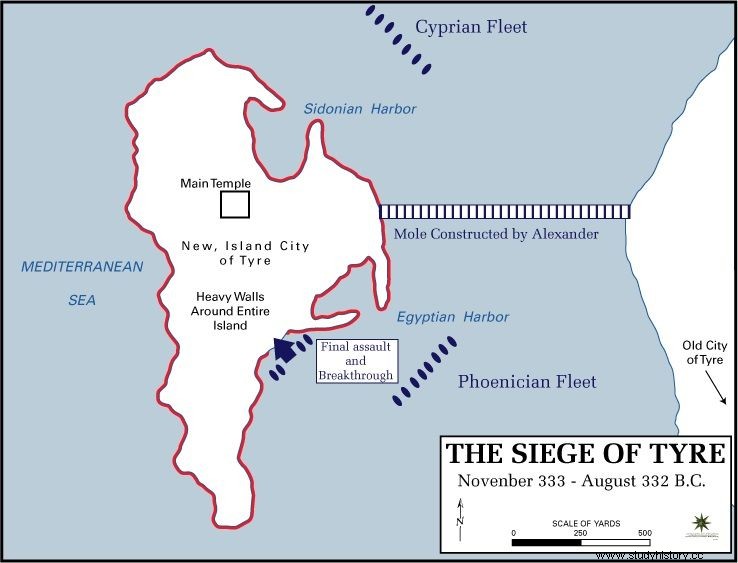
Only the gathering of an appropriate fleet would weigh the tide of victory on the side of Alexander. Pictured is a map of the Siege of Tire by Frank Martini of the Department of History, United States Military Academy (source:public domain).
Preparations for the final assault
Macedonian engineers built special floating rams . Some of the ships were made into assault landing units. There are platforms on them with hooks to attach to the walls. With their help, Alexander the Great's elite guard, in haste, were to break into the fortress. Other ships, armed with catapults, were to check the defenders.
The entrance to the port was blocked by a fleet of attackers. Nevertheless, the Tyrian ships from time to time managed to go to sea unnoticed and harass Macedonian ships:

Tyrians sailed on ships shielded with protective walls towards three-row anchors and cut the anchor lines, thus preventing enemy ships from landing.
Alexander then placed a lot of thirty-Words across from the anchors, shielded in a similar manner. (…) But this time their anchor lines were cut off again by the divers underwater .
Alexander the Great Victory
Nature came to the rescue twice during the siege. The first time the storm severely damaged the causeway, the second time it scattered Macedonian ships. However, Alexander was unfazed. The day finally came when the causeway was completed. It was in July 332 B.C.
Before the final assault, Alexander gave his soldiers a few days of rest. The attack began with the bombing of the walls in places weakened by the earlier shelling. Squadrons of ships loaded with archers and slingers were circling around the island that supported landing troops wherever it was needed.
Despite these difficult moments, the defenders of Tire prepared another unpleasant surprise for their enemies. It was an ancient version of napalm:hot sand mixed with small pebbles . While falling from above, it penetrated the slits of the attackers' armor, blinded them and caused extensive burns.
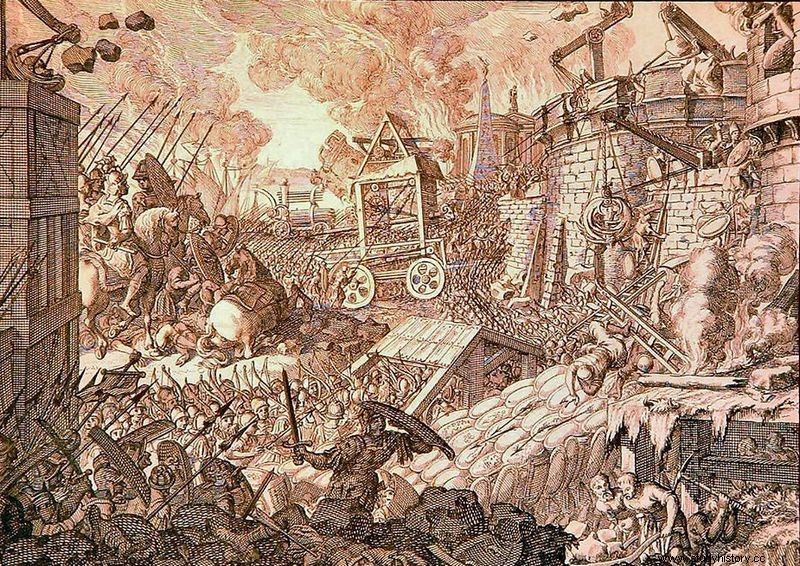
Despite the heroic attitude of the defenders, nothing could save Tire (source:public domain).
But nothing could save Tire anymore. In the end, part of the fortress walls collapsed. Landing ships with Aleksander's guardsmen approached the breach and threw their piers. The Macedonian ruler himself led the attackers. The narrow streets of the city ran over with the blood of its inhabitants.
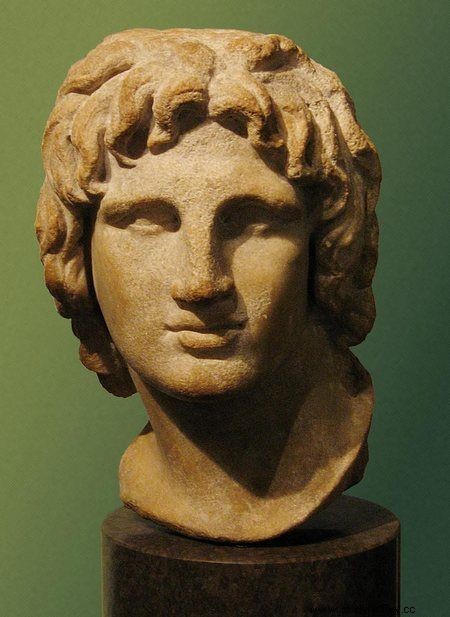
The conquest of Tire was one of the greatest successes of Alexander the Great (photo:Andrew Dunn; license CC ASA 2.0).
About six thousand defenders died in the fights described. Two thousand young men capable of carrying arms were crucified on the beach as a warning to all those who would like to resist the victorious leader in the future. Other residents in the number of 27 thousand. they were sold into slavery.
The conquest of Tire by Alexander the Great is considered one of his greatest successes. The innovative weapons used by him are particularly noteworthy.
Landing ships or the use of engineering troops on such a large scale are rather the domain of the armies of the twentieth century. And because of the nature and ferocity of battles, historians often compare them to the battles at Stalingrad and Leningrad during World War II.
